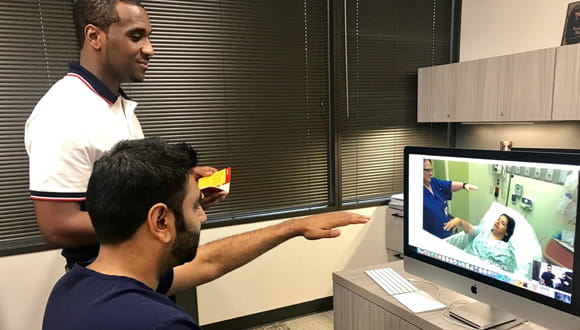Every Second Counts When Stroke Is the Suspect: Dr. Clyburn's Story
June 22, 2022 - Patti MuckEvery year, about 800,000 people suffer strokes in the United States. It is a leading cause of death and costly disability around the world.
Neurologists say "time is brain," because strokes that are treated quickly — ideally within three hours — can lead to excellent outcomes with no lingering brain damage or disability.
In other words, if a stroke is suspected, we need to be fast, which provides the basis for the updated acronym to help you recognize stroke's warning signs and respond appropriately: BEFAST. The letters stand for balance, eyes, face, arm, speech and time. Abnormalities in any of the first five words means it's time to call for help.
What follows is a story showing the outstanding outcome that resulted when a classic stroke was treated quickly and expertly.
Every second counts when stroke is the suspect: Dr. Clyburn's story
Houston Methodist orthopedic surgeon Dr. Terry Clyburn was catching up on paperwork in his Outpatient Clinic 25th floor office when he started feeling tingling on the left side of his face.
He didn't think much of it. Then he noticed his left hand felt numb and weak. He reached for his desk phone but couldn't hold the receiver. It dropped to the desk with a thud.
"I thought, 'this is bad,' " Dr. Clyburn recalls. He used both hands to pick up the phone again. "I called my primary care physician (Dr. James Muntz), and said, 'Jim, I think I'm having a stroke.'"
The next several minutes were critical to Dr. Clyburn's ability to tell his story today.
Clyburn headed for Dr. Muntz's distant office, walking to the off-stage elevators. He waited two or three minutes and by the time he got on the elevator, his left leg was getting numb and he was having trouble walking. He decided to change directions and immediately walk toward the emergency department (ED).
Dr. Ben Saldana, medical director of Houston Methodist Emergency Care Centers, got word that Dr. Clyburn was headed his way. He called neurologist Dr. John Volpi and the Houston Methodist stroke team, and the ED went into stroke-code mode.
On his way through the hospital, Dr. Clyburn crossed paths with several colleagues. As they greeted him and asked how he was doing, he felt his left foot dragging and getting weaker by the minute. When he finally got to the emergency department's front desk, he literally flopped over the counter and announced his stroke.
"I was completely, totally exhausted," he recalls.
Suddenly, three people appeared behind Dr. Clyburn with a wheelchair and whisked him down the hall, assessing his symptoms on the way. "Smile," they ordered. "Grip my hand." They attached a blood pressure cuff and rolled him straight to a CT machine to check for bleeding in the brain.
"We knew we'd give tPA (tissue plasminogen activator) if he was not on blood thinners and had no history of bleeding in the brain," Dr. Saldana recalls. "It was a classic case. He described heaviness/numbness on his left side. He was 66 but had no risk factors."
A clot-busting drug, tPA acts quickly to restore blood flow to the brain. As soon as Dr. Clyburn's blood pressure was low enough, Dr. Saldana administered the drug.
"I could tell the difference within minutes of the administration of the tPA," Dr. Clyburn remembers. "I could feel that I was gripping better. They were moving my foot up and down. With each of the exams, I could feel myself getting stronger." He went home the next day and returned to work soon after.
"The therapeutic results of tPA are pretty miraculous," says Dr. Saldana, who works frequently with Houston Methodist's stroke team and virtual stroke team. Dr. Volpi and neurologist Dr. Rajan Gadhia have created a platform with high resolution cameras so ED physicians at any regional Houston Methodist hospital can communicate virtually with the stroke team and determine a plan of care. If a blood clot is involved, the team arranges transfer to one of three — soon to be four — Houston Methodist hospitals that perform thrombectomy, or clot retrieval.
Four years later, Dr. Clyburn remains grateful that if he had to suffer a stroke, he was in the right place at the right time. Before that scary day, he'd planned to travel to a small town in Oklahoma, an hour and a half from the nearest medical center, to participate in an auto-racing competition. Fortuitously, he'd canceled the trip at the last minute because his knee and hip replacement surgery schedule had become too busy.
"I just feel absolutely blessed that I was sitting here in the Texas Medical Center in Houston Methodist Hospital when it happened," Dr. Clyburn says. "Every step of the way, everything was just smooth, organized, rapid."
The only thing different since his stroke is a good change. Dr. Clyburn says he's now a compliant patient who faithfully takes the medications prescribed by his doctors.


